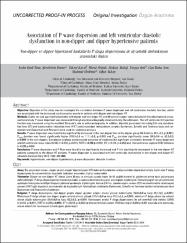Association of P wave dispersion and left ventricular diastolic dysfunction in non-dipper and dipper hypertensive patients

View/
Access
info:eu-repo/semantics/openAccessDate
2014Author
Demir, ŞerafettinKaya, Yüksel
Selçuk, Murat
Akdağ, Serkan
Işık, Turay
Arin, Can Baba
Özdemir, Mahmut
Akkuş, Oğuz
Metadata
Show full item recordAbstract
Objective: Objective of this study was to investigate the correlation between P wave dispersion and left ventricular diastolic function, which are associated with the increased cardiovascular events in patients with dipper and non-dipper hypertensive (HT). Methods: Eighty sex and age matched patients with dipper and non-dipper HT, and 40 control subject were included in this observational cross-sectional study. P wave dispersion was measured through electrocardiography obtained during the admission. The left ventricular ejection fraction was measured using the modified Simpson's rule by echocardiography. In addition, diastolic parameters including E/A rate, deceleration time (DT) and isovolumetric relaxation time (IVRT) were recorded. Independent samples Bonferroni, Scheffe and Tamhane tests and correlation test (Spearman and Pearson) were used for statistical analysis. Results: P wave dispersion was found to be significantly increased in the non-dipper than in the dipper group (56.0 +/- 5.6 vs. 49.1 +/- 5.3, p<0.001). P-max duration was found significantly higher (115.1 +/- 5.6 vs. 111.1 +/- 5.8, p=0.003) and P-min duration significantly lower (59.0 +/- 5.6 vs. 62.3 +/- 5.3, p=0.009) in the non-dippers. Correlation analysis demonstrated presence of moderate but significant correlation between P-wave dispersion and left ventricular mass index (r=0.412, p=0.011), IVRT (r=0.290 p=0.009), DT (r=0.210, p=0.052) and interventricular septum thickness (r=0.230 p=0.04).
Conclusion: P wave dispersion and P Max were found to be significantly increased and P min significantly decreased in the non-dipper HT patients compared to the dipper HT patients. P-wave dispersion is associated with left ventricular dysfunction in non-dipper and dipper HT.

















